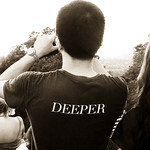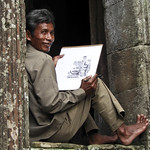Visiting Angkor Wat
I decided to spend three days at the temple complexes surrounding Siem Reap, Angkor Wat being the most famous. Although if you do it in one day, there will be a lot you won’t see, you can do the highlights in one day. Specifically if you’ve got a tuk tuk or taxi to drive you around.
The tuk tuks, here, are actually not really tuk tuks. They’re really motorbikes with something of a cart attached to their back. They seat two comfortably and could fit three. I think they’re called remorque motos.
Interestingly, foreigners are not allowed to drive motorbikes here in Siem Reap, at least according to the guys renting out bicycles.
My first stop was Angkor Wat, of course, which I found very nice, but not as impressive as I’d expected. After Sukhotai, Ayuthaya, but also Teotihuacan, the lesser known Prasat Meuang Singh Historical Park and some of the mansions in Kashan, I couldn’t say I was structurally more than ‘pleased’ when seeing this 12th century temple.
Unfortunately, the central five towers of Angkor Wat have been closed to the public for the last nine months. A guide I asked suggested that, maybe, they might open again next year.
An important bas relief at Angkor Wat is the “Churning of the Ocean of Milk”, which relates to a Hindu epic where good and bad demons fight over the world’s destiny, with the gods chipping in their bit. The good ones eventually win, of course, helped by Vishnu, in the shape of a turtle with a pivot on his back for turning a mountain around it. Sound familiar? Probably not, eh. It didn’t to me. But that turtle did ring a bell.
The image of the turtle with the pivot on his back I’ve seen myself in several places. Amongst them Mongolia and Japan, both having very little to nothing of a connection with Hinduism. Particularly in Mongolia, where the turtle with the pivot on its back has been around since the time of Chinggis, if not longer, this is at least remarkable. Chinggis and friends were animists though Mongolia’s buddhism was introduced by Tibetan monks.
Still, I’m surprised that this purely Hindu motif somehow ended up in mainstream buddhism.
My second stop was the Angkor Thom complex. With ‘Thom’ meaning ‘Grand’, it’s much larger than Angkor Wat. The moat alone is 100 meters… wide and over two kilometers long on all sides. That’s larger than the moat in Chiang Mai. And this was just a palace!
Inside Angkor Thom, the most striking sight, but not in a good way, was the reclining buddha at the back of the Baphuon, a three-tired temple pyramid with a long horizontal entrance ramp. Angkor Thom was built shortly after Angkor Wat, but a few hundred years later, the decision was made to partially demolish the Baphuon to use the building blocks for constructing a 70 meter reclining buddha.
So far so good, except that the reclining buddha was made mostly by just stacking up the blocks removed from the temple. Needless to say, before construction was done, part of the reclining buddha had already collapsed.
A surprising degeneration of craftsmanship.
Before I made the long walk up Phnom Bakheng, a 65 meter high five tiered pyaramid and the first to be built in this area, around the year 900, allowing for decent views of the surrounding sights, if you can handle the hundreds of fellow tourists, I went up to Preah Khan, a huge but crumbling temple complex just north from Angkor Thom.
Backdrops
Cambodia has the highest HIV infection rate in Asia. This is, at least in part, due to the presence of UN stabilization forces in the 1990s and the resulting flourishing prostitution sector.
The Lonely Planet claims that Thonle Sap, a large lake in the middle of the country, is Asia’s largest freshwater lake. However, this would be Lake Baikal.















































































































